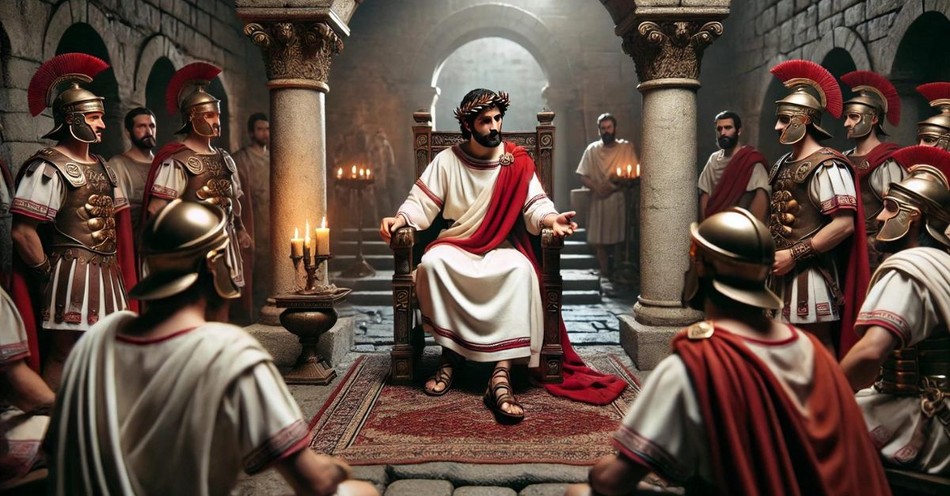Pontius Pilate was the Roman prefect (governor) of Judea from AD 26–36 who presided over Jesus’ trial and authorized his crucifixion. In the Gospel accounts, we see Pilate attempting to balance Roman politics and local pressure from the Jews. He ultimately condemned Jesus to death, while symbolically “washing his hands” of the decision.
Pilate had political power and imperial responsibility. He only had a short rule as governor, but God still used him for a particular purpose within the redemptive story of Jesus.
Who Was Pontius Pilate? Historical Background
Since Pilate served in a major imperial position, historians outside the Bible mention him—the Jewish historian Josephus, Philo the Alexandrian philosopher, and the Roman historian Tacitus.
Pilate ruled as the Roman governor of Judea from 26 AD to 36 AD under Emperor Tiberius. Pilate probably earned the role through connections with the Roman knight Sejanus, who had great influence in Tiberius’s court. As one of the equestrian class, Pilate didn’t become a senator but still held power within the Roman government.
As a governor, or praefectus, Pilate was responsible for maintaining order in the Judean province. This was not easy since the Jews regularly revolted, and there were racial and religious tensions. Pilate’s duties would have included collecting taxes, managing public works, dispensing justice, and commanding troops. Roman governors were the ultimate authority in legal matters, especially cases involving execution.
Josephus records an event soon after Pilate arrived, when he introduced military standards in Jerusalem with images of the Roman emperor. The Jewish religious law didn’t allow any “graven images,” particularly of a man claiming to be a god, so this provoked major protest. Pilate refused to remove the standards at first, but ultimately removed them after continued protests.
In another event, Pilate used money from the Jewish Temple treasury to build an aqueduct. Despite how this project improved daily life, Jews believed it to be a sacrilege. Protests broke out again. Pilate disguised Roman soldiers as Jews, placed them in the crowd, and ordered them to use violence to end the demonstration. Bloodshed erupted, ending the protest. This made Pilate into more of a villain to the Jews.
The philosopher Philo mentions another conflict about shields with Tiberius’s name, which Pilate hung in Herod’s palace in Jerusalem. They didn’t have an image, only a name, but the Jews still looked at this as an insult. A Jewish delegation appealed to Emperor Tiberius, who later ordered Pilate to remove the shields to Caesarea, publicly rebuking the governor.
Pilate’s governorship ended after he mishandled a Samaritan rebellion. The Romans harshly oppressed the Samaritans, falsely claiming they gathered for rebellion. Samaritan leadership complained to Roman officials in Syria, who brought Pilate before Rome to answer for his violent action. Before Pilate could resolve the issue, Tiberius died, and Pilate was removed from his position with a transition to new leadership.
History records Pilate as a harsh, oppressive governor who often made obtuse decisions, misunderstanding the religious and cultural realities of Judea and the Jewish people. History provides fascinating context for what we read about him in the Bible.
Pilate’s Role in Biblical History
All four Gospels include Pilate as a main figure in the final hours of Jesus’ life, and each writer shows Pilate’s moral weakness and legal authority as a bad combination.
The Jewish leaders brought Jesus to Pilate because they didn’t have the power to execute Christ; only Pilate had that legal right under Roman law. The Sanhedrin brought Jesus to the governor and accused him of stirring rebellion and calling himself king. The Jews meant to manipulate Pilate. He didn’t want another rebellion and had already been villainized in the region and rebuked by the emperor.
So Pilate questioned Jesus, asking if he was the King of the Jews. Jesus responded, “You say I am,” both telling the truth but not defending himself. After the interrogation, Pilate didn’t find Jesus guilty and tried to release him, having Christ whipped almost to death first, attempting to appease the religious leaders. But they cried for Jesus’ crucifixion. Pilate then offered to set Jesus free as part of the Passover custom. But the crowd had been incensed by the chief priests, and the Jews chose the rebel, Barabbas, instead. Regarding Jesus, they cried out, “Crucify him!”
The Bible mentions one reason Pilate sought to release Jesus. His wife had a disturbing dream and warned him to have nothing to do with Jesus. Ultimately, Pilate caved to the pressure of Jewish leadership, hoping to avoid another riot, and was swayed by ironic Jewish claims of loyalty to Caesar as their only king. Pilate washed his hands before the people, a symbol of his own lack of responsibility in killing Jesus.
During crucifixion, the Romans placed the crime on a sign above the condemned. Pilate ordered the sign above Jesus to say “the King of the Jews” in the main languages of the region and the empire, all to the chagrin of the Jewish leadership. He kept the sign up despite their protests.
After Jesus’ death, Pilate granted permission to Joseph of Arimathea to take the body of Christ and bury it in a new tomb. The governor put Roman guards at the tomb since the Jewish leaders thought the disciples would steal the body. Jesus had taught that he would rise from the dead. However, despite all these safeguards, the tomb was empty Sunday morning.
Why Pontius Pilate Is Included in the Gospels
Pontius Pilate’s role in the Gospel story reveals an important theme in Christian history. As the Roman governor, he represented the imperial power ruling over God’s people, much like Old Testament rulers after the Jewish exile. Pilate’s inclusion shows the tension between earthly power and God’s Kingdom people, before and after Jesus.
In the Old Testament, after Israel’s exile, they lived under foreign rule. Nebuchadnezzar destroyed Jerusalem and carried the Jews into captivity. While Cyrus later allowed them to return and rebuild, they still did so under imperial power. Though both kings were pagan rulers, God used them to fulfill his plans. In a similar way, Pilate became a ruling figure, representative of Rome, and someone God used to accomplish his redemptive work of salvation.
For the early church, Pilate’s role in the story reminded Christians what they could expect from earthly rulers. Just as Jesus suffered under Roman authority and the Jewish religious leaders, Christ’s disciples would face persecution from the same empire and nations to come. Christians then and today live under governments that either misunderstand, marginalize, or openly resist believers. Pilate’s moral weakness and injustice revealed his priority: political power over truth.
Today we must remind ourselves how the Kingdom of God doesn’t spread through earthly politics but through faith, obedience, and even suffering. Just as God used pagan kings and Roman officials to further his redemptive story, he can and will do the same in our time. God’s sovereignty remains over all other powers to bring his salvation, even among unjust human governments.
What Was Jesus' Interaction with Pilate?
Just like Christ, his disciples can learn what kind of truths to declare before the governments of the world. Jesus mainly kept silent, but he also declared important truths before the earthly power.
In John 18:36, Jesus said, “My kingdom is not of this world.” Christ clarified how much greater and deeper (spiritual) his kingdom was. He didn’t come to overthrow Rome but to establish a forever kingdom through love and truth. This confused Pilate, of course. He didn’t expect a heavenly claim.
In the next verse, Pilate asked if Jesus was a king. Jesus answered, “You say that I am a king. For this purpose I was born and for this purpose I have come into the world—to bear witness to the truth. Everyone who is of the truth listens to my voice.” While affirming his position as heavenly king, Jesus also spoke of the purpose of his whole life—to be a witness to the truth. He himself is truth, and his love, teaching, death, and resurrection all manifested the eternal reality.
When Pilate pleaded with Jesus, claiming Roman authority, Jesus declared something radical but important: “You would have no authority over me at all unless it had been given you from above” (John 19:11). Pilate thought he had authority over Jesus’ life, but Jesus knew where the real power resided: his Father. Everything is subject to God.
These statements before Pilate reveal to us our position before any earthly government. We’ve been made inheritors of the same heavenly kingdom, and we are citizens of the same. Jesus didn’t respond with earthly power or violence; he trusted his Father and the truth to win out. With Christ within us by the Holy Spirit, we live and speak the truth of a greater kingdom than any on earth.
How Did Pontius Pilate Die?
Unfortunately, we don’t have the details of Pilate’s death. Ancient sources offer conflicting accounts. After Tiberius died, history doesn’t mention Pilate again.
Some traditions say Pilate was exiled and later committed suicide after his downfall. Eusebius, a Christian historian in the fourth century, writes that Pilate killed himself out of despair. Other legends suggest a more redemptive end, claiming Pilate actually converted to Christianity and became a martyr. These stories have no historical evidence, and their conflicting traditions show how early Christians tried to use this popular Gospel figure for their own ends.
While history records interesting things about Pilate, giving great context, he is ultimately remembered for his place in the story of Jesus, and not in the best way. Let us learn how to stand for truth and love, declaring the Good News of the Kingdom of God before all earthly powers for their eternal good.
Pontius Pilate Quick Answers
1. Who was Pontius Pilate?
The Roman prefect (governor) of Judea from AD 26–36 who presided over Jesus’ trial and ordered His crucifixion.
2. What authority did Pilate have?
As prefect, Pilate controlled military forces, tax collection, and capital punishment—making him the final authority in Jesus’ case.
3. Why is Pilate significant in the Bible?
He conducted Jesus’ Roman trial, questioned him about kingship and truth, and authorized the crucifixion under the charge “King of the Jews.”
4. Do sources outside the Bible mention Pilate?
Yes—Josephus and Tacitus reference him, and the “Pilate Inscription” (found at Caesarea Maritima) confirms his title and governorship.
5. Was Pilate sympathetic to Jesus?
The Gospels portray him as reluctant yet politically expedient, declaring he found no fault in Jesus, but yielding to the Jewish crowd and pressure of the Jewish leaders.
6. What happened to Pilate after Jesus’ death?
Ancient traditions say he was recalled to Rome after handling a Samaritan uprising; his fate afterward is uncertain.
Peace.
Image created using DALL.E 2024 AI technology and subsequently edited and reviewed by our editorial team.





.jpg)